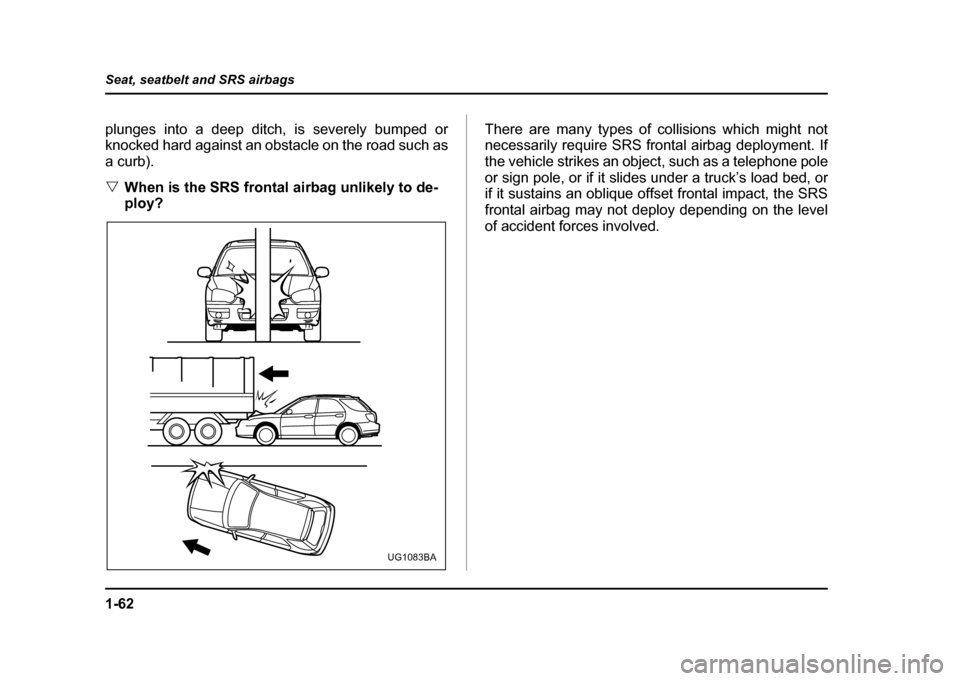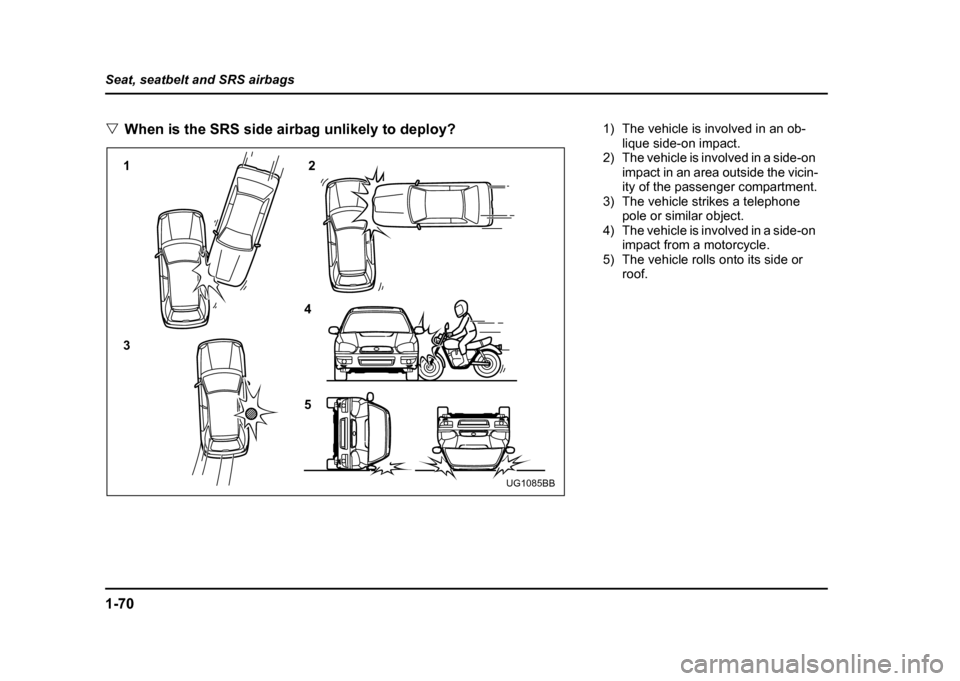2004 SUBARU IMPREZA phone
[x] Cancel search: phonePage 13 of 491

10
you have a medical condition that requires you to take
drugs, please consult with your doctor.
Never drive if you are under the influence of any illicit
mind-altering drugs. For your own health and well-be-
ing, we urge you not to take illegal drugs in the first
place and to seek treatment if you are addicted to
those drugs. !Driving when tired or sleepy
When you are tired or sleepy, your reaction will
be delayed and your perception, judgment and
attentiveness will be impaired. If you drive
when tired or sleepy, your, your passengers’
and other persons’ chances of being involved
in a serious accident may increase.
Please do not continue to drive but instead find a safe
place to rest if you are tired or sleepy. On long trips,
you should make periodic rest stops to refresh your-
self before continuing on your journey. When possible,
you should share the driving with others. !
Modification of your vehicle
Your vehicle should not be modified. Modifica-
tion could affect its performance, safety or du-
rability, and may even violate governmental
regulations. In addition, damage or perfor-
mance problems resulting from modification
may not be covered under warranties.
! Mobile phones and driving
Do not use a hand-held phone while driving; it
may distract your attention from driving and
can lead to an accident. If you use a hand-held
phone, pull off the road and park in the safe
place before using your phone. In some States/
Provindes, only hands-free phones may legally
be used while driving.
Page 89 of 491

1-62
Seat, seatbelt and SRS airbags
plunges into a deep ditch, is severely bumped or
knocked hard against an obstacle on the road such as a curb). "
When is the SRS frontal airbag unlikely to de-
ploy? There are many types of collisions which might not
necessarily require SRS frontal airbag deployment. If
the vehicle strikes an object, such as a telephone pole
or sign pole, or if it slides under a truck’s load bed, or
if it sustains an oblique offset frontal impact, the SRS
frontal airbag may not deploy depending on the level
of accident forces involved.
UG1083BA
Page 97 of 491

1-70
Seat, seatbelt and SRS airbags "
When is the SRS side airbag unlikely to deploy?
12 3 4 5
UG1085BB
1) The vehicle is involved in an ob-
lique side-on impact.
2) The vehicle is involved in a side-on impact in an area outside the vicin-
ity of the passenger compartment.
3) The vehicle strikes a telephone pole or similar object.
4) The vehicle is involved in a side-on impact from a motorcycle.
5) The vehicle rolls onto its side or roof.
Page 259 of 491

6-10
Interior equipment
Cigarette lighter socket
The electrical power outlet located on the lower part of
the instrument panel can be used as cigarette lighter
socket. A cigarette lighter plug is an optional accesso-
ry. It is available from your SUBARU dealer.
The cigarette lighter socket may also be used as a
power source for an in-car use electrical appliance.
"
The electrical power outlet located on the
lower part of the instrument panel is originally
designed to use a SUBARU genuine cigarette lighter plug. Do not use non-genuine cigarette
lighter plugs in the socket. Doing so may cause
a short-circuit and overheating, resulting in afire. "
If the socket is ever used for a plug-in acces-
sory such as a mobile phone, that may damage
the portion of the socket’s internal mechanism
that causes a cigarette lighter plug to “pop out”
after its lighter element is heated. Therefore, do
not place a cigarette lighter plug in a socket
that has been used, even once, to power a plug-
in accessory. Doing so may cause the plug to
stick and overheat, creating a potential fire haz-
ard. " Do not place any foreign objects, especially
metal ones such as coins or aluminum foil, into
the socket. That could cause a short circuit.
UG6509DA
Page 320 of 491

8-9
Driving tips
– CONTINUED –
!All AWD models except OUTBACK
SPORT and vehicles with 17 inch tires
Your AWD vehicle is neither a conventional off-road
vehicle nor an all terrain vehicle. It is a passenger car
designed primarily for on-road use. The AWD feature
gives it some limited off-road capabilities in situations
in which driving surfaces are relatively level, obstruc-
tion-free and otherwise similar to on-road driving con-
ditions. Operating it under other than those conditions
could subject the vehicle to excessive stress which
might result in damage not eligible for repair under
warranty. If you do take your SUBARU off road, you
should review the common sense precautions in the
next section (applicable to the OUTBACK SPORT) for
general guidance. But please keep in mind that your
vehicle’s off-road capabilities are more limited than
those of the OUTBACK SPORT.
Never attempt to drive through pools and puddles, or
roads flooded with water. Water entering the engine
air intake or the exhaust pipe or water splashing onto
electrical parts may damage your vehicle and may
cause it to stall. ! OUTBACK SPORT
Your Subaru can be driven on ordinary roads or off-
road. But please keep in mind that an AWD SUBARU is a passenger car and is neither a conventional off-
road vehicle nor an all-terrain vehicle. If you do take
your Subaru off-road, certain common sense precau-
tions such as the following should be taken: "
Make certain that you and all of your passengers
are wearing seat belts. " Carry some emergency equipment, such as a tow-
ing rope or chain, a shovel, wheel blocks, first aid kit
and portable phone or citizens band radio." Drive carefully. Do not take unnecessary risks by
driving in dangerous areas or over rough terrain. " Slow down and employ extra caution at all times.
When driving off-road, you will not have the benefit of
marked traffic lanes, banked curves, traffic signs and
the like. " Do not drive across steep slopes. Instead, drive ei-
ther straight up or straight down the slopes. A vehicle
can much more easily tip over sideways than it can
end over end. Avoid driving straight up or down slopes
that are too steep. " Avoid sharp turning maneuvers, especially at higher
speeds. " Do not grip the inside or spokes of the steering
wheel. A bad bump could jerk the wheel and injure
your hands. Instead drive with your fingers and
thumbs on the outside of the rim. " If driving through water, such as when crossing
Page 483 of 491

14-4
Index
Front
........................................................................... 11-33
Rear ............................................................................ 11-34
Dimensions .................................................................... 12-2
Disarming the system ................................................ 2-17
Disc brake pad wear warning indicators ............7-29
Dome light ............................................................ 6-2, 11-77
Door locks ....................................................................... 2-3
Door open warning lights .........................................3-25
Drive belts ....................................................................... 11-27
Driver’s control center differential ........................7-18
Auto indicator light ................................................ 3-26
Indicator light .......................................................... 3-27
Driving
Drinking ..................................................................... 8
Drugs .......................................................................... 9
Foreign countries .................................................. 8-6
Mobile phone .......................................................... 10
Pets ............................................................................. 10
Tips ........................................................... 7-14, 7-17, 8-7
Tired or sleepy ........................................................ 9
Snowy and icy roads ............................................ 8-13
E
EBD (Electronic brake force distribution) system ......................................................................... 7-32
Electrical system .......................................................... 12-3Electronic Brake force Distribution (EBD)
system .......................................................................... 7-32
Emergency Locking Retractor (ELR) ...................1-14
Engine Compartment overview ........................................11-8
Coolant ....................................................................... 11-19
Exhaust gas (Carbon monoxide) .....................8, 8-3
Hood ............................................................................ 11-5
Oil ................................................................................. 11-11
Overheating .............................................................. 9-16
Starting ....................................................................... 7-9
Stopping ..................................................................... 7-11
Exterior care ................................................................... 10-2
F
Flat tires ............................................................................ 9-5
Floor mat .......................................................................... 6-13
Fluid level
Automatic transmission .......................................11-31
Brake ........................................................................... 11-37
Clutch .......................................................................... 11-38
Power steering ........................................................ 11-36
Fog light switch ............................................................. 3-35
Folding down the rear seat .......................................1-12
Front Differential gear oil ................................................. 11-33
Fog light ..................................................................... 11-73